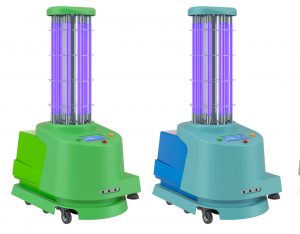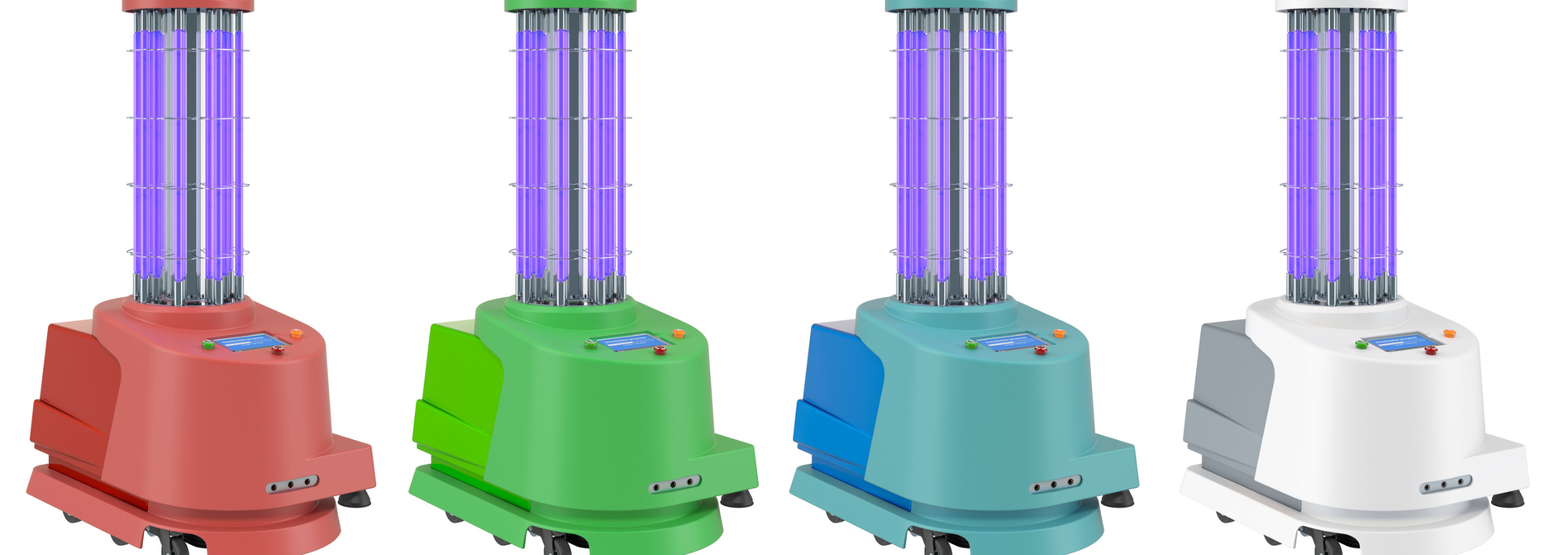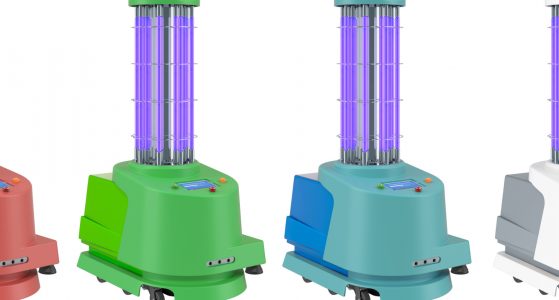Service robots have been used in the medical field for many years with robots assisting with surgery, roaming bots with tablets allowing for physician tele-visits and even drones delivering emergency medical equipment. Robots have many other applications in the healthcare industry such as UV light disinfection robots which are becoming increasingly popular in hospitals to disinfect patient rooms, operating rooms, common surfaces, and medical equipment.
UV Light Disinfection Robots: Not Entirely a New Concept
 Even before the global COVID-19 pandemic, hospitals across the country were investing in UV light disinfection robots, according to this article in Robotics Business Review magazine published in March of 2019. Hospital-acquired infections (HAIs) have always been a concern as some of the most commonly transmitted HAIs are “superbugs” which are resistant to antibiotics. MRSA (methicillin-resistant Staphylococcus aureus), VRE (Vancomycin-resistant enterococci), C. diff. (Clostridium difficile) and other superbugs cause serious pain and suffering and may even cause death.
Even before the global COVID-19 pandemic, hospitals across the country were investing in UV light disinfection robots, according to this article in Robotics Business Review magazine published in March of 2019. Hospital-acquired infections (HAIs) have always been a concern as some of the most commonly transmitted HAIs are “superbugs” which are resistant to antibiotics. MRSA (methicillin-resistant Staphylococcus aureus), VRE (Vancomycin-resistant enterococci), C. diff. (Clostridium difficile) and other superbugs cause serious pain and suffering and may even cause death.
Cleaning and disinfection practices are a significant concern and one of the greatest costs of the modern healthcare sector. Hospitals must always maintain diligence in disinfection procedures to prevent hospital-acquired infections and studies have been conducted on the efficacy of UV light robots long before the COVID-19 pandemic.
This study from the National Institutes of Health from 2017, Application of Service Robots for Disinfection in Medical Institutions, concludes that semi-automated UV light systems such as UV light robots were effective in substantially reducing the burden of MRSA and bacteria on surfaces, including in vacated patient rooms known to have been infected with MRSA.
MRSA is in the beta coronavirus family, similar to the SARS-CoV-2 virus that causes COVID-19. Several recent studies have shown that UV light may be as effective at eliminating the SARS-CoV-2 virus as other coronaviruses, including MRSA, with the right conditions and exposure. According to the Food and Drug Administration, FDA, as of February 2021 there was still limited published data on the dose, duration, and wavelength required to inactivate the SARS-CoV-2 virus.
More UV Light Robots Roaming Hospital Halls
Since the onset of the coronavirus pandemic, hospitals have been faced with new challenges in preventing the spread of COVID-19 amidst record capacity levels with many patients infected with the deadly SARS-CoV-2 virus. On top of treating high patient levels, healthcare workers at times had to deal with shortages in protective personal equipment (PPE), putting staff and patients at an increased risk of infection.
Hospitals across the country sought new tools and innovative methods to protect patients and staff. UV light disinfection robots provided a valuable tool as more hospitals began implementing mobile ultraviolet technology to aid in the fight against COVID-19. The Henry Ford Health System in Detroit invested in 20 UV light robots as reported in December of 2020, the Norman Regional Health Systems in Oklahoma purchased 6 UV light disinfection robots in July of 2020, as well as many other hospitals and medical facilities.
Hospitals are not the only application where UV light robots have been used to combat infectious disease. Airports, mass transit stations, libraries, schools, shopping malls, and many other public places have invested in autonomous virus killers on wheels to protect against the spread of germs.
UVC Disinfection Devices
A UVC disinfection robot is one of several devices where UV technology is used to eliminate harmful germs. Additional UV disinfection devices include air purification systems, water treatment systems, and additional surface disinfection technologies. UVC disinfection devices typically use UVC germicidal mercury lamps due to their high effectiveness and low cost.
Air purification systems are often installed as a wall-mounted unit or in HVAC systems and help to clean and purify the air that we breathe by eliminating harmful airborne pathogens. UVC lights mounted over surgical equipment and in operating rooms help to provide surface disinfection and UV water treatment systems eliminate harmful pathogens from water supplies in many applications. While air and water UV purification systems are still widely in use in many environments, the use of UV light disinfection robots has increased with a greater awareness of the effectiveness and benefits that mobility devices provide.
Advantages of UV Light Disinfection Robots
UV light robots should be considered for use only in addition to manual cleaning practices and never relied upon for sole disinfection purposes. UV wavelengths are more effective when hitting a clean surface as dirt can trap microorganisms that may be difficult to be eradicated by UV light. Hospitals and other applications that have employed the use of UV light robots have realized many advantages such as:
- Semi-automatic operation – staff can be trained to operate the UV robots, which can be programmed to follow a particular path in a patient room, focusing UV rays in hard-to-reach places, and can automatically return back to a charging station.
- Highly effective – UV light robots have been proven to significantly reduce harmful levels of pathogens to safe levels, in addition to manual cleaning practices.
- No labor expenses – UV robots have become part of the staff in many hospitals, even given names of their own. Robots, however, never ask for a lunch break, a day off, or overtime pay.
- Low maintenance – UVC germicidal lamps provide thousands of hours of effective disinfection with low maintenance and low ongoing costs.
- No additional cleaning chemicals – UV lamps provide high disinfection efficacy with no need to purchase and store chemical cleaners.
Return on investment – UV light robots provide a worthwhile return on investment to hospitals by reducing costs of extended hospital stays due to HAIs, which occur in 1 out of 31 patients according to the Centers for Disease Control and Prevention, CDC. Additionally, by eliminating superbugs from patient rooms and saving even one life due to a serious infection, this added level of disinfection is priceless.
UVC Germicidal Lamps for UV Light Disinfection Robots
LightSources and LightTech, together with our valuable partner companies, comprise the LightSources group, which is recognized as a world-leading UV lamp supplier. We offer a wide selection of UVC disinfection lamps, with various proven technologies, sizes, and styles, and custom-engineered germicidal lamp solutions available. Our UV lamp engineers possess deep technical knowledge of UV radiation and lamp design to provide customized solutions, including custom phosphor blends and proprietary technologies, to meet the needs of innovative original equipment manufacturers (OEMs) of all sizes.
Our UVC germicidal lamps for UV light robots include:
- Low-pressure Mercury lamps
- Medium-pressure UVC lamps
- Compact quartz lamps
- Standard quartz
- High-output quartz
- Standard softglass
- High-output softglass
- Amalgam lamps with proprietary technology
- UVC ozone lamps
- Custom lamp bases and sockets
- Electronic ballasts
Our proprietary technology Shatter ProTech provides a cost-efficient solution to protect lamps and the environment with a shield that is acid and heat-resistant and fits any lamp geometry. Our additional proprietary lamp technologies give our customers an added competitive advantage with high-quality, cost-effective UV lamp products for any germicidal application.
LAMP PRODUCT DATA:
UV Germicidal LampsLAMP Applications:
UV Germicidal ApplicationsThe LightSources group represents the leading high-tech UV lamp engineers and manufacturers in the industry. We offer UVC disinfection lamps to a multitude of applications worldwide with OEM oriented, patent protected solutions. Contact us to learn more about our UVC lamps and technologies for UV light disinfection robots.
This post is also available in:
 Chinese (Simplified)
Chinese (Simplified)  Spanish
Spanish  German
German


